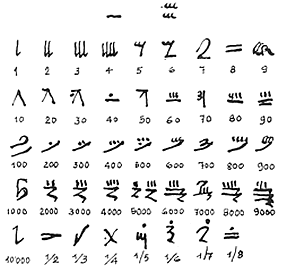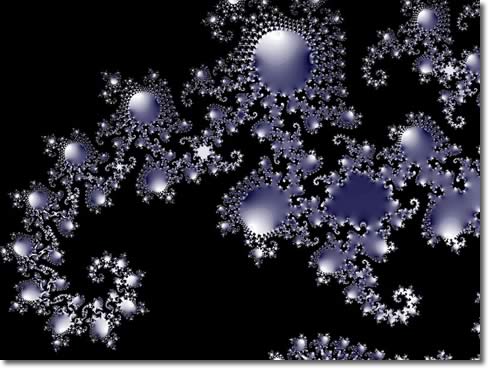Index: The Essential Numbers of the Masonic Work and the minimal rules of their Archaic Symbolism - The evolution of the art of Numbers in the Western school - Two procedures to reveal "the secret of a Number"
The Essential Numbers of the Masonic Work and the minimal rules of their Archaic Symbolism
When changing the language used so far and creating a more essential ‘form’, we should find an agreement on the minimal value to give the concepts we will find in those new aspects of number, symbol and sound.
We will find out later, when we advance through our journey, the need for certain explanations that we are going to deal with now.
The evolution of the art in Numbers in the Western school
Yesterday's:
The first certain traces of the use of numeration in the present era goes back to 3,500 B.C. The only living element of the previous eras is the Myth in the memory of man. It is obvious from the traces engraved in the bones in the following image, that the first numeration method used by modern man is the sign.

Today's:

The Rhind Papyrus dated 1650 B.C. shows the last evolution of the Egyptian numeral system that influenced the whole Arab world.
Whilst the evolution of the numeral art of the Indian system in the Arab and Western world is expressed clearly in the second table below.
The penetration in Europe of this last system occurred gradually.

According to the official history everything started in the 8th century at the hands of Caliph Al-Mansur who invited a delegation of Indian scientists to Baghdad to illustrate to his scholars the high degree reached in that Nation in the field of astronomy and mathematics.
Following this initiative, the scholar Al-Khwarizmi, member of the Academy the House of Wisdom between the 7th and 9th centuries divulged Indian arithmetic in the Arab world, by publishing the treaty: "On the Indian numerical arithmetic". This work was later presented in Europe as well in the Latin translation titled: "De Numero Indorum". It is presumed that the first scholar to introduce the advantages of the Indian numerical system in Italy was Gerbert d’Aurillac who became pope in 999 with the name of Sylvester 2nd.
But only in the 12th century that system spread widely in the European mathematical school and this happened thanks to the work of eminent scholars of the time, such as the famous Leonardo Fibonacci from Pisa, creator of the mathematical-musical sequence that took his name, and author in 1202 of the book called Liber abaci, which is still a current reference.
And tomorrow's - fractal numbers and multi-dimensional geometry
Fractals’ geometry is a science in full development that still holds many surprises for researchers.
Irregularity, continuity and analogy of all the worlds of the form are only some of the aspects of the fractals’ research.
In actual fact fractal geometry is a window through which man looks at the fourth dimension: the metaphysical concept of the form.


Chaos in Wonderland by Clifford Pickover
Two operations to reveal "the secret of a Number"
We must learn two simple operations that esotericists have always applied to reveal the synthetic number hidden in every figure.
The first operation illuminates the synthesis of the form aspect, whilst the second reveals its essence.
The Bro might even apply these two operations on himself and thus discover in a mathematical key the imprint that affects his profane as well as his esoteric life.
Both operations have been recently accompanied (MDCCC) by the term theosophical, from Greek theosophia, where sophia is knowledge, theòs of godly things.
This term, though, has the fault of limiting in (cultural) time and space two arithmetical operations that we constantly find both in the Kabbalah’s calculations and in Pythagorean mathematics’ philosophy.
Addition
Let’s take, as an example, a random number: 984570; the result is obtained by adding the individual numbers of the figure in question and extracting its synthesis,
9 + 8 + 4 + 5 + 7 + 0 = 33 and continuing the operation with 3 + 3 = 6
The synthetic number of this figure is 6, its symbol is the hexagram  .
.
By joining the meanings of the number 6 and its symbol, we can interpret the form aspect of that number or what is connected to it. For example, if we considered a number connected to a date of a historical event, an occurrence or a birth, through this operation we would be able to find the exterior meaning connected to the event itself:
4th April 1882 = 4 + 4 + 1 + 8 + 8 + 2 = 27, 2 + 7 = 9. Therefore we will go in search of the meanings connected to this last Number.
If we wanted to study this further, we might look for what is called the secret value of the number, using:
Reduction
Performing this calculation, |
n |
= |
n |
x |
n + 1
_____
2 |
Which in our instance equals: |
9 |
= |
9 |
x |
9 + 1
_____
2 |
= |
45 |
= |
9 |
As far as the exoteric part is concerned, then, we should analyze the meanings connected with the Number 9 and its symbology (see) but if we needed more esoteric information on this Number, we should consider those expressed by the ninth Card of the Greater Arcana in the Tarots, the Hermit, in its hermetic interpretation derived from the sacerdotal wisdom in the use of the golden Cards of the god Toth (see for example the authors Arthur E. Waite or Oswald Wirth), excluding of course the interpretation of some charlatans.
The same method could be applied on a year in a general sense as well as in a particular one, e.g.:
year 1994 |
= |
5 (numerical value) |
 (symbolic value) (symbolic value) |
as a Card: the Hierophant, |
its reduction
5 |
= |
5 |
x |
5 + 1
_____
2 |
= |
15 |
= |
6 (numerical value) |
 (symbolic value) (symbolic value) |
as a Card: the Lovers. |
These are the values to develop in order to know the conditions of that year; for the exoteric possibilities the 5, the  and the 5th Card of the Greater Arcana; for the esoteric ones, the 6, the
and the 5th Card of the Greater Arcana; for the esoteric ones, the 6, the  and the 6th Card of the Greater Arcana.
and the 6th Card of the Greater Arcana.
But if we want to study further the conditions in particular, we will add the current year of age of that person, for example the 46th year for a fourty-five year old. Using the previous method and calculating the year that’s passing, we will have:
Exoteric conditions, |
46 |
= |
4 |
+ |
6 |
= |
10 |
= |
1 |

|
the Card: the Magician; |
Esoteric conditions, |
1 |
= |
1 |
x |
1 + 1
_____
2 |
= |
1 |

|
the Card: the Magician. |
Here is that the fourty-six year old used as an example will have for the year 1994, in his exoteric influence, the conditions expressed by the Numbers 5/planetary and 6/personal; for further details he will be able to add to these numbers the conditions inscribed in the relative Cards connected to those figures.
For those who would like to undertake the use of the Greater Arcana in the Tarots without adding the interpretative value to the Numbers, we must remind them that in this instance the two-digit number will be put in relation to the corresponding Card and it will have the exoteric meaning (exterior life) whilst the reduction to one digit and therefore to the corresponding Card will be considered as an esoteric value (inner life). Particular meanings will be drawn from the interpretation of the double numbers matched to the value of the remaining 56 cards called Lesser Arcana that go from Card n. 23 to Card n. 78.
I would like to remind the Bro that each of the 22 Cards of the Tarots esoterically matches each of the 22 paths that cross the Sephirotic System. There are 10 Sephiro and 22 paths that connect them; n. 1, Da^ath, is the invisible Sephir because it is metaphysical.
10+22+1 = 33.
And 33 are indeed the levels of the hierarchic Pyramid of the White or Initiatory Freemasonry.
Through these two simple operations the Bro is initiated to move the first steps in the esoteric interpretation of the Numbers.
He will then be able to apply this interpretation to any topic of research. 
